R-class: Difference between revisions
Pbcjohnston (talk | contribs) Added R-15 group photo and caption. |
Pbcjohnston (talk | contribs) mNo edit summary |
||
| (28 intermediate revisions by 2 users not shown) | |||
| Line 1: | Line 1: | ||
[[ | {{#seo:|title=U.S. Navy R-class submarine - PigBoats.COM|title_mode=replace|keywords=US R-class submarines}} | ||
< | {{#seo:|description=Notes, photographs, and pictures of the U.S. Navy's R-class submarines.}} | ||
[[File: | |||
The 27 R-class submarines were built to two distinctly different designs at three shipyards. Both designs had similar operational and military characteristics, but had vastly different internal arrangements, equipment installations, and external appearances. The two designs were developed by the Electric Boat Company (EB) of New York City (later Groton, CT.) and the Lake Torpedo Boat Company of Bridgeport, CT. R-1 through R-14 were of the EB design and were built at Bethlehem Quincy near Boston (formerly Fore River Shipbuilding Company). R-15 through R-20 were of the EB design and built at Bethlehem San Francisco (formerly Union Iron Works). R-21 through R-27 were built by Lake at his Bridgeport yard. | [[File:New Header 1 R-class.jpg]] | ||
=== <big>Design and Construction Notes</big> === | |||
<div style="text-align: justify;"><span style="color:#00008B"> | |||
[[File:R-14 Christley Illustration updated.jpg|left|500px|Illustration by Jim Christley, exclusive to PigBoats.COM. MAY NOT be used without permission.]]The 27 R-class submarines were built to two distinctly different designs at three shipyards. Both designs had similar operational and military characteristics, but had vastly different internal arrangements, equipment installations, and external appearances. The two designs were developed by the Electric Boat Company (EB) of New York City (later Groton, CT.) and the Lake Torpedo Boat Company of Bridgeport, CT. R-1 through R-14 were of the EB design and were built at Bethlehem Quincy near Boston (formerly Fore River Shipbuilding Company). R-15 through R-20 were of the EB design and built at Bethlehem San Francisco (formerly Union Iron Works). R-21 through R-27 were built by Lake at his Bridgeport yard. | |||
The illustration at left is by artist and historian Jim Christley, done exclusively for PigBoats.COM. It shows the general, as built configuration of the EB design for the R-class. The Lake design for this class differed extensively (see below). | |||
The Bethlehem Quincy yard was a very busy place as they were also building a plethora of surface ships. Bethlehem San Francisco and the Lake yards were much less busy so they were the first ones to lay keels for this class. Quincy followed several months later as they cleared up their construction back log. This lead to an unusual situation when it came to deck guns. The originally specified gun for the class was the [https://pigboats.com/index.php?title=Submarine_Guns#Deck_Guns '''3"/23 caliber Mk 9 semi-retractable mount''']. Since they were the first to be laid down the San Francisco built units received that gun. With the Quincy and Lake units lagging behind the Navy made the decision to have the designs altered to include a mount for the more capable 3"/50 caliber Mk 7 Mod 19 gun, which required an expanded deck sponson that allowed enough room to operate the gun. All of the Quincy and Lake units were built with foundation and sponson for the newer gun but actually didn't receive it until after they were commissioned, due to production delays. The San Francisco built R-15 through R-20 all spent the first several months of their service with the older gun. In the spring of 1919 they all went into overhaul at Mare Island prior to their deployment to Hawaii. They received the new gun and sponson during this overhaul. | |||
While these boats were serving in Hawaii in the 1920's, some of them carried an unusual visual identification scheme. A large geometric shape was painted in white on the sides of the conning tower fairwater. This shape could be seen a long distances, making the boat easy to identify for fleet exercises. The following are the boats that carried the shape scheme and what the shape was: | |||
[[File:R-19 Pearl Harbor.jpg|left|frameless|450px|Photo in the private collection of Ric Hedman.]]<br> | |||
•R-11: = (two horizontal stripes)<br> | |||
•R-12: X<br> | |||
•R-13: ★<br> | |||
•R-14: ♦<br> | |||
•R-15: ■<br> | |||
•R-16: ●<br> | |||
•R-17: ▲<br> | |||
•R-19: +<br> | |||
•R-20: ǀǀǀ (three vertical stripes)<br><br><br><br> | |||
The use of the shape scheme was limited to the Hawaii area and was abandoned in favor of the boat's name even before they returned to the states. | |||
All of the EB design boats were modified for greater safety in the aftermath of the [https://pigboats.com/index.php?title=Notable_Submarine_Accidents#S-4_(SS-109),_Collision_with_USCGC_Paulding,_December_17,_1927 '''S-4 disaster''']. They received escape trunks and hatches, salvage air connections, and the ability to mate with the McCann Rescue Chamber. | |||
The legal provisions of the WWI era construction programs forced the Navy to accept all of the warships that had been contracted for construction during that time. After the war ended, the Navy found itself with more ships than it felt it needed for peacetime operations so scores of ships and submarines were laid up in reserve. The Lake design R-boats were all sent to Philadelphia for inactivation after only about five years of service. They were destined to be scrapped in the early 1930's to keep the USN in compliance with the London Naval Treaty. That same treaty forced the USN to lay up many of the EB design R-boats in 1930-1931. However, the EB design boats were retained, and most were reactivated for service as WWII kicked off in Europe. Several of these boats served in WWII as stateside training submarines. None made war patrols in the Pacific, although a few made anti U-boat patrols in the Caribbean. [[R-12|'''USS R-12 (SS-89)''']] was lost on June 12, 1943 off Key West due to hull failure. There were just five survivors. The rest of the crew are "on eternal patrol". | |||
The class is broken down by groups below.</span></div> | |||
[[File:Red bar sub.jpg]] | |||
=== <big>R-1 through R-14 (EB design built at Bethlehem Quincy)</big> === | |||
[[File:R-class boats at NYC 1.jpg|left|500px|U.S. Navy photo.]] | |||
<div style="text-align: justify;"><span style="color:#00008B">R-class submarines of Submarine Division 9, circa December 1919, moored to the submarine tender USS Camden (AS-6) at the 79th Street Boat Basin in Manhattan's west side. At the top of the photo is [[S-3|'''S-3 (SS-107)''']] and [[S-4|'''S-4 (SS-109)''']]. The boats were in port for a visit while enroute to the Gulf of Mexico for big fleet maneuvers. Later, in April 1921, SubDiv 9 was transferred to San Pedro and arrived there on June 30, 1921. We know this photo was taken on the 1919 trip since the R-9 did not transfer to the Pacific until 1924 and she is seen in these photos. Note that only R-10 and R-3 have guns installed. The R-boats would later receive 3"/50 caliber Mk 7 Mod 19 weapons while the S-boats would receive 4"/50 caliber Mk 12 guns.</span></div> | |||
[[R-1 through R-14|See more of this group]] | |||
[[File:Red bar sub.jpg]] | [[File:Red bar sub.jpg]] | ||
[[File:6 r under construction.jpg|left| | |||
In this photo are all six of the R-class submarines assigned for construction to Bethlehem San Francisco. The photo was taken on 03 March 1918 and shows the boats after launching but before completion and commissioning. The three boats in the foreground are (L to R) the R-16, 17, and 18. In the background (order unknown) are the R-15, 19, and 20. When the construction contracts for the boats were written the yard was known as Union Iron Works. By the time of this photo the yard had been acquired by Bethlehem Steel and was properly known as Bethlehem San Francisco (BSF). | === <big>R-15 through R-20 (EB design built at Bethlehem San Francisco)</big> === | ||
[[File:6 r under construction.jpg|left|500px|National Archives photo.]] | |||
<div style="text-align: justify;"><span style="color:#00008B">In this photo are all six of the R-class submarines assigned for construction to Bethlehem San Francisco. The photo was taken on 03 March 1918 and shows the boats after launching but before completion and commissioning. The three boats in the foreground are (L to R) the R-16, 17, and 18. In the background (order unknown) are the R-15, 19, and 20. When the construction contracts for the boats were written the yard was known as Union Iron Works. By the time of this photo the yard had been acquired by Bethlehem Steel and was properly known as Bethlehem San Francisco (BSF). | |||
BSF launched their boats with much of the superstructure and the conning tower fairwater yet to be installed, and with a false bow that was later replaced with the permanent one prior to completion. This is in marked contrast to the Bethlehem Quincy (BQ) yard near Boston (previously known as Fore River Shipbuilding) that built their group of R-boats with most of the superstructure complete and the conning tower fairwater in place. The cylindrical ribbed tower in the center of each boat is the pressure proof conning tower itself, used as a periscope station for making submerged attacks. Later in the construction phase a sheet steel fairwater would be built around the conning tower to provide a smooth flow of water around the tower, to provide a bridge for the Officer of the Deck and lookouts while surfaced, and to provide supports for the periscopes. | BSF launched their boats with much of the superstructure and the conning tower fairwater yet to be installed, and with a false bow that was later replaced with the permanent one prior to completion. This is in marked contrast to the Bethlehem Quincy (BQ) yard near Boston (previously known as Fore River Shipbuilding) that built their group of R-boats with most of the superstructure complete and the conning tower fairwater in place. The cylindrical ribbed tower in the center of each boat is the pressure proof conning tower itself, used as a periscope station for making submerged attacks. Later in the construction phase a sheet steel fairwater would be built around the conning tower to provide a smooth flow of water around the tower, to provide a bridge for the Officer of the Deck and lookouts while surfaced, and to provide supports for the periscopes. | ||
The docks on both sides of the submarines are stacked with huge amounts of materials for ship construction. BSF was also building destroyers and civilian merchant ships at this time and much of this material may be for those ships, as some of it is too large for submarines. What looks like huge sheets of cork insulation are stacked near the center of the photograph. This was applied to the interior of the pressure hull to help control the temperature of the interior of the boat. It was also to prevent condensation from dripping all over the crew and equipment causing discomfort and electrical shorts and grounds. There are also piping unions, elbows, and junctions stacked around seemingly by the hundreds.< | The docks on both sides of the submarines are stacked with huge amounts of materials for ship construction. BSF was also building destroyers and civilian merchant ships at this time and much of this material may be for those ships, as some of it is too large for submarines. What looks like huge sheets of cork insulation are stacked near the center of the photograph. This was applied to the interior of the pressure hull to help control the temperature of the interior of the boat. It was also to prevent condensation from dripping all over the crew and equipment causing discomfort and electrical shorts and grounds. There are also piping unions, elbows, and junctions stacked around seemingly by the hundreds.</span></div> | ||
[[R-15 through R-20|See more of this group]] | |||
[[R-15 through R-20|See more of this group]] | |||
[[File:Red bar sub.jpg]] | [[File:Red bar sub.jpg]] | ||
[[File:Lake R-class drawing.jpg|left| | |||
An excellent line drawing of the Lake design for the R-class. Simon Lake finally abandoned the concept of | === <big>R-21 through R-27 (Lake design built at Lake Torpedo Boat Company)</big> === | ||
[[File:Lake R-class drawing.jpg|left|500px|Drawing by Jim Christley courtesy of Navsource.org]] | |||
<div style="text-align: justify;"><span style="color:#00008B">An excellent line drawing by artist/historian Jim Christley of the Lake design for the R-class. Simon Lake finally abandoned the concept of zero angle diving with midships diving planes in this class, at the Navy's insistence. The flat horizontal stern and the ventrally mounted rudder, stern planes, and propeller shafts are quite apparent.</span> | |||
[[R-21 through R-27|See more of this group]] | [[R-21 through R-27|See more of this group]] | ||
[[File:Red bar sub.jpg]] | |||
=== <big>General R-class group photos.</big> === | |||
[[File:R-boats in NYC.jpg|left|500px|U.S. Navy photo.]] | |||
<div style="text-align: justify;"><span style="color:#00008B">The R-class submarines of Submarine Division 9, circa December 1919, moored to the submarine tender USS Camden (AS-6) at the 79th Street Boat Basin with Manhattan's west side skyline visible in the background. | |||
[[R-class group photos|See more R-class group photos]] | |||
[[File:Red bar sub.jpg]] | |||
<center>[[Submarine Classes|Return to the Submarine Classes page]]</center> | |||
[[File:Red bar sub.jpg]] | |||
<center> | |||
<span style="color:#00008B"> | |||
Page created by:<br> | |||
<small>Ric Hedman & David Johnston<br> | |||
1999 - 2023 - PigBoats.COM<sup>©</sup><br> | |||
Mountlake Terrace, WA, Norfolk, VA<br> | |||
webmaster at pigboats dot com</small> | |||
</center> | |||
[[File:Subs bottom line 2.jpg]] | |||
Latest revision as of 20:16, 17 May 2025
Design and Construction Notes
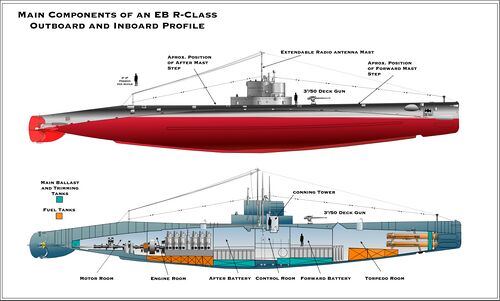
The illustration at left is by artist and historian Jim Christley, done exclusively for PigBoats.COM. It shows the general, as built configuration of the EB design for the R-class. The Lake design for this class differed extensively (see below).
The Bethlehem Quincy yard was a very busy place as they were also building a plethora of surface ships. Bethlehem San Francisco and the Lake yards were much less busy so they were the first ones to lay keels for this class. Quincy followed several months later as they cleared up their construction back log. This lead to an unusual situation when it came to deck guns. The originally specified gun for the class was the 3"/23 caliber Mk 9 semi-retractable mount. Since they were the first to be laid down the San Francisco built units received that gun. With the Quincy and Lake units lagging behind the Navy made the decision to have the designs altered to include a mount for the more capable 3"/50 caliber Mk 7 Mod 19 gun, which required an expanded deck sponson that allowed enough room to operate the gun. All of the Quincy and Lake units were built with foundation and sponson for the newer gun but actually didn't receive it until after they were commissioned, due to production delays. The San Francisco built R-15 through R-20 all spent the first several months of their service with the older gun. In the spring of 1919 they all went into overhaul at Mare Island prior to their deployment to Hawaii. They received the new gun and sponson during this overhaul.
While these boats were serving in Hawaii in the 1920's, some of them carried an unusual visual identification scheme. A large geometric shape was painted in white on the sides of the conning tower fairwater. This shape could be seen a long distances, making the boat easy to identify for fleet exercises. The following are the boats that carried the shape scheme and what the shape was:
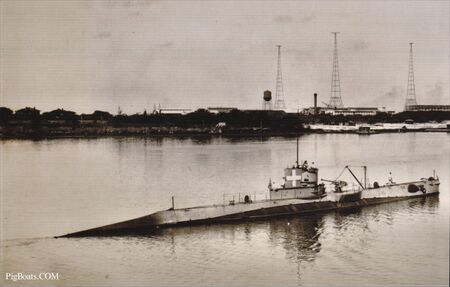
•R-11: = (two horizontal stripes)
•R-12: X
•R-13: ★
•R-14: ♦
•R-15: ■
•R-16: ●
•R-17: ▲
•R-19: +
•R-20: ǀǀǀ (three vertical stripes)
The use of the shape scheme was limited to the Hawaii area and was abandoned in favor of the boat's name even before they returned to the states.
All of the EB design boats were modified for greater safety in the aftermath of the S-4 disaster. They received escape trunks and hatches, salvage air connections, and the ability to mate with the McCann Rescue Chamber.
The legal provisions of the WWI era construction programs forced the Navy to accept all of the warships that had been contracted for construction during that time. After the war ended, the Navy found itself with more ships than it felt it needed for peacetime operations so scores of ships and submarines were laid up in reserve. The Lake design R-boats were all sent to Philadelphia for inactivation after only about five years of service. They were destined to be scrapped in the early 1930's to keep the USN in compliance with the London Naval Treaty. That same treaty forced the USN to lay up many of the EB design R-boats in 1930-1931. However, the EB design boats were retained, and most were reactivated for service as WWII kicked off in Europe. Several of these boats served in WWII as stateside training submarines. None made war patrols in the Pacific, although a few made anti U-boat patrols in the Caribbean. USS R-12 (SS-89) was lost on June 12, 1943 off Key West due to hull failure. There were just five survivors. The rest of the crew are "on eternal patrol".
The class is broken down by groups below.R-1 through R-14 (EB design built at Bethlehem Quincy)

R-15 through R-20 (EB design built at Bethlehem San Francisco)
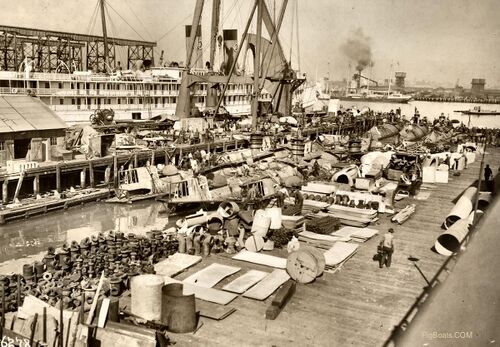
BSF launched their boats with much of the superstructure and the conning tower fairwater yet to be installed, and with a false bow that was later replaced with the permanent one prior to completion. This is in marked contrast to the Bethlehem Quincy (BQ) yard near Boston (previously known as Fore River Shipbuilding) that built their group of R-boats with most of the superstructure complete and the conning tower fairwater in place. The cylindrical ribbed tower in the center of each boat is the pressure proof conning tower itself, used as a periscope station for making submerged attacks. Later in the construction phase a sheet steel fairwater would be built around the conning tower to provide a smooth flow of water around the tower, to provide a bridge for the Officer of the Deck and lookouts while surfaced, and to provide supports for the periscopes.
The docks on both sides of the submarines are stacked with huge amounts of materials for ship construction. BSF was also building destroyers and civilian merchant ships at this time and much of this material may be for those ships, as some of it is too large for submarines. What looks like huge sheets of cork insulation are stacked near the center of the photograph. This was applied to the interior of the pressure hull to help control the temperature of the interior of the boat. It was also to prevent condensation from dripping all over the crew and equipment causing discomfort and electrical shorts and grounds. There are also piping unions, elbows, and junctions stacked around seemingly by the hundreds.R-21 through R-27 (Lake design built at Lake Torpedo Boat Company)
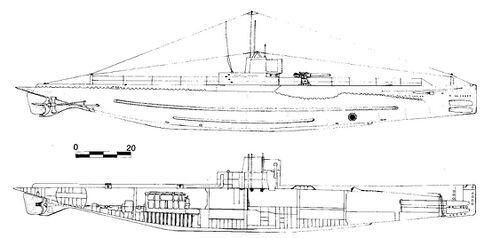
General R-class group photos.
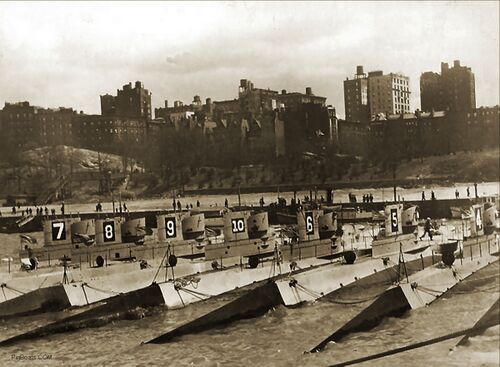
Page created by:
Ric Hedman & David Johnston
1999 - 2023 - PigBoats.COM©
Mountlake Terrace, WA, Norfolk, VA
webmaster at pigboats dot com
